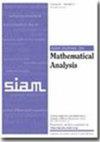Pinning in the Extended Lugiato–Lefever Equation
IF 1.9
2区 数学
Q1 MATHEMATICS, APPLIED
引用次数: 0
Abstract
SIAM Journal on Mathematical Analysis, Volume 56, Issue 3, Page 3679-3702, June 2024.Abstract. We consider a variant of the Lugiato–Lefever equation (LLE), which is a nonlinear Schrödinger equation on a one-dimensional torus with forcing and damping, to which we add a first-order derivative term with a potential [math]. The potential breaks the translation invariance of LLE. Depending on the existence of zeroes of the effective potential [math], which is a suitably weighted and integrated version of [math], we show that stationary solutions from [math] can be continued locally into the range [math]. Moreover, the extremal points of the [math]-continued solutions are located near zeros of [math]. We therefore call this phenomenon pinning of stationary solutions. If we assume additionally that the starting stationary solution at [math] is spectrally stable with the simple zero eigenvalue due to translation invariance being the only eigenvalue on the imaginary axis, we can prove asymptotic stability or instability of its [math]-continuation depending on the sign of [math] at the zero of [math] and the sign of [math]. The variant of the LLE arises in the description of optical frequency combs in a Kerr nonlinear ring-shaped microresonator which is pumped by two different continuous monochromatic light sources of different frequencies and different powers. Our analytical findings are illustrated by numerical simulations.
扩展卢吉亚托-勒弗弗方程中的针刺效应
SIAM 数学分析期刊》,第 56 卷,第 3 期,第 3679-3702 页,2024 年 6 月。 摘要。我们考虑了 Lugiato-Lefever 方程(LLE)的一个变体,LLE 是一维环上的非线性薛定谔方程,具有强迫和阻尼。该势打破了 LLE 的平移不变性。有效势[math]是[math]的一个适当加权和积分版本,根据有效势[math]零点的存在,我们证明[math]的静止解可以局部延续到[math]范围内。此外,[math]续解的极值点位于[math]的零点附近。因此,我们称这种现象为静止解的针化。如果我们额外假设[math]处的起始静止解是频谱稳定的,平移不变性导致的简单零特征值是虚轴上唯一的特征值,那么我们就可以根据[math]零点处[math]的符号和[math]的符号来证明其[math]续集的渐近稳定性或不稳定性。LLE 的变体产生于对克尔非线性环形微谐振器中光学频率梳的描述,该谐振器由两个不同频率和不同功率的连续单色光源泵浦。我们的分析结果通过数值模拟加以说明。
本文章由计算机程序翻译,如有差异,请以英文原文为准。
求助全文
约1分钟内获得全文
求助全文
来源期刊
CiteScore
3.30
自引率
5.00%
发文量
175
审稿时长
12 months
期刊介绍:
SIAM Journal on Mathematical Analysis (SIMA) features research articles of the highest quality employing innovative analytical techniques to treat problems in the natural sciences. Every paper has content that is primarily analytical and that employs mathematical methods in such areas as partial differential equations, the calculus of variations, functional analysis, approximation theory, harmonic or wavelet analysis, or dynamical systems. Additionally, every paper relates to a model for natural phenomena in such areas as fluid mechanics, materials science, quantum mechanics, biology, mathematical physics, or to the computational analysis of such phenomena.
Submission of a manuscript to a SIAM journal is representation by the author that the manuscript has not been published or submitted simultaneously for publication elsewhere.
Typical papers for SIMA do not exceed 35 journal pages. Substantial deviations from this page limit require that the referees, editor, and editor-in-chief be convinced that the increased length is both required by the subject matter and justified by the quality of the paper.

 求助内容:
求助内容: 应助结果提醒方式:
应助结果提醒方式:


